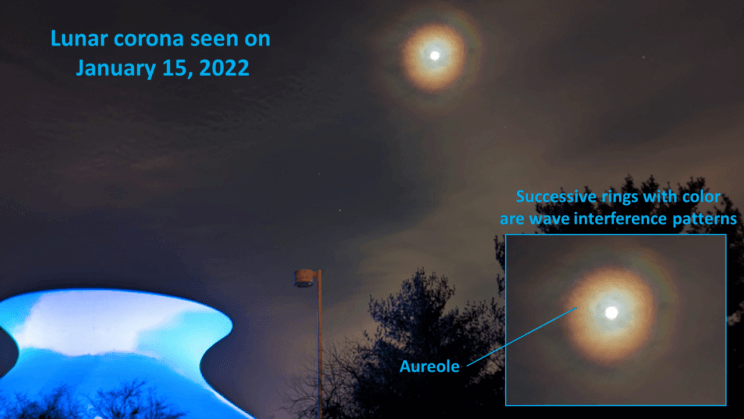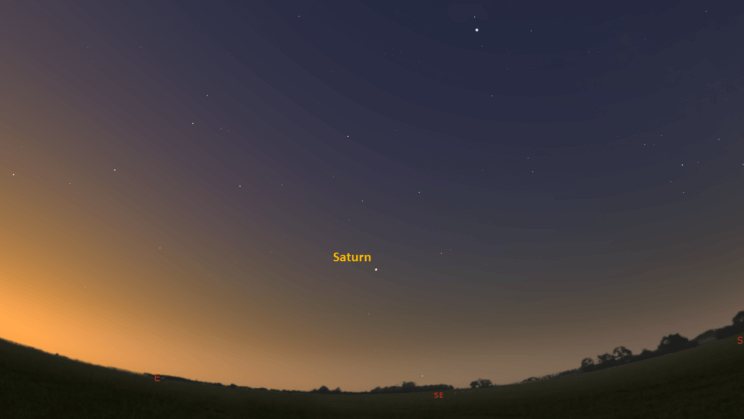This is the Saint Louis Science Center’s NIGHT SKY UPDATE for the week of Friday, April 28, 2023.
Information updated weekly or as needed.
Times given as local St. Louis time which is Central Daylight Time (CDT). For definitions of terminology used in the night sky update, click the highlighted text. If relying on times posted in Universal Time (UT), St. louis is -5 hours when CDT.
Public Telescope Viewings
As part of the Saint Louis Science Center’s First Fridays, weather permitting, the St. Louis Astronomical Society and the Science Center will set up a number of telescopes outdoors and be on-hand to answer your questions. Telescope viewing begins once it is dark. Regardless of the weather on May 5, join us indoors in our planetarium theater for “The Sky Tonight”. Showtime is at 7 p.m.
Observing Highlight of the Week

Lunar corona seen on January 15, 2022. Notice the corona is slightly egg shaped. This is because the moon phase that night was gibbous. Image credit: Eric Gustafson.
This week we will see the Moon exhibit waxing gibbous phases as it heads towards full moon on May 5, 2023. On April 28, 2023, the Moon will appear 59% illuminated. By May 6, 2023, The Moon will reach the waning part of the synodic cycle and it will appear as a waning gibbous moon 98% illuminated.
Cloud cover is generally a problem for observing, but this week if we do have some cloud cover, it is a good time to be on the lookout for atmospheric optics. Atmospheric optics occur as the atmosphere interacts with light. The twinkling of stars is a good example. As starlight passes through our atmosphere, the path light travels before reaches our eyes is distorted. This makes stars appear to twinkle which is called scintillation. Atmospheric optics are commonly associated with the Moon as it approaches its full phase. Lunar corona and Lunar halos are common to see provided the right conditions exist. Ice crystals and other particulates in the atmosphere can have an interesting effect on any light source reflected or emitted.
A penumbral lunar eclipse occurs on May 5, 2023, but it will not be visible from St. Louis. The next lunar eclipses visible from St. Louis are not until 2024. A penumbral lunar eclipse occurs on March 24/25, 2024, and a partial lunar eclipse occurs on September 17/18, 2024.
While not related to the Moon, May 1st each year is a cross quarter day marking the halfway point between spring and summer. In ancient times, this day would have marked the beginning of summer, while the solstice would have been midsummer. Several traditions around the world celebrate this day each year. One such tradition is called Beltane. This was the Celtic fire festival that began the night before May 1st. In ancient times, Beltane celebrated the return of summer while Samhain (Halloween) celebrated the start of winter. Numerous traditions around the world such as Beltane are connected to astronomical events.
The Sun and Moon

The Moon as seen from the International Space Station, on July 31, 2011.
Credit: NASA
Sunrise is at 6:07 a.m. on Friday, April 28 and sunset is at 7:50 p.m. providing us with over 13.5 hours of daylight. Even after sunset, light from the Sun will dimly illuminate our sky for roughly 1 hour and 40 minutes. This period is called twilight, which ends around 9:30 p.m. this week. For those with a sundial, local noon occurs around 12:58 p.m. this week.
| Day | Sunrise | Sunset | ||||||||||
|---|---|---|---|---|---|---|---|---|---|---|---|---|
| 28-Apr | 6:07 a.m. | 7:50 p.m. | ||||||||||
| 29-Apr | 6:06 a.m. | 7:51 p.m. | ||||||||||
| 30-Apr | 6:05 a.m. | 7:52 p.m. | ||||||||||
| 1-May | 6:04 a.m. | 7:53 p.m. | ||||||||||
| 2-May | 6:02 a.m. | 7:54 p.m. | ||||||||||
| 3-May | 6:01 a.m. | 7:55 p.m. | ||||||||||
| 4-May | 6:00 a.m. | 7:55 p.m. | ||||||||||
| 5-May | 5:59 a.m. | 7:56 p.m. | ||||||||||
| 6-May | 5:58 a.m. | 7:57 p.m. |
Moon
Moonrise for Friday, April 28 is at 12:53 p.m. and moonset occurs at 3:27 a.m. on the following day. Friday, April 28, the Moon will exhibit a waxing gibbous phase with 59% of the lunar disk illuminated. Full moon occurs on May 5, 2023, at 12:34 p.m.
International Space Station (ISS) Observing

There are several visible passes of ISS from St. Louis for the week of April 28. They occur during morning hours. The best passes for this week are listed below. Use the table below for information about these passes.
Catch ISS from St. Louis starting Friday, April 28
| Date | Starts | Max. altitude | Ends | |||||||
|---|---|---|---|---|---|---|---|---|---|---|
| Time | Alt. | Az. | Time | Alt. | Az. | Time | Alt. | Az. | ||
| 01 May | -0.1 | 2:54:31 | 15 | NE | 2:54:31 | 15 | NE | 2:55:16 | 10 | NE |
| 02 May | -1.3 | 3:40:08 | 16 | NNW | 3:40:14 | 16 | NNW | 3:42:26 | 10 | NNE |
Magnitude (Mag): The Measure of brightness for a celestial object. The lower the value is, the brighter the object will be.
Altitude (Alt): The angle of a celestial object measured upwards from the observer’s horizon.
Azimuth (Az): The direction of a celestial object, measured clockwise from an observer’s location with north being 0°, east being 90°, south being 180° and west being 270°.
For information about ISS flyovers and other visible satellites, visit www.heavens-above.com
Detailed information regarding all unmanned exploration of our universe, missions past, present, and planned, can be found at Jet Propulsion Laboratories:
The Visible Planets

Looking west at 8:20 p.m. on April 30, 2023. Credit: Stellarium, EG

Looking Southeast at 5:30 a.m. on May 1, 2023. Credit: Stellarium, EG
This week, three naked eye planets will be visible. Venus and Mars are found in the west after sunset. Saturn is now visible in the southeast about 30 minutes before sunrise.
Venus
Venus is now well into its current evening apparition. Venus will be a bright target in the west after sunset until August 2023 when it approaches inferior conjunction. This week, look for Venus in the west about 20 minutes after sunset. Venus sets at 11:21 p.m.
Mars
Mars now rises before sunset, becoming visible once it is dark. Look for it high in the west about 30 minutes after sunset. Mars sets at 1:14 a.m.
Saturn
Saturn is slowly climbing out of the Sun’s glare about 30 minutes before sunrise. For many of us, Saturn may still be too low to spot due obstruction along the horizon. 30 minutes before sunrise, Saturn will appear roughly 10° above the southeastern horizon.
James S. McDonnell Planetarium
Night Sky Update: April 28 – May 6, 2023






